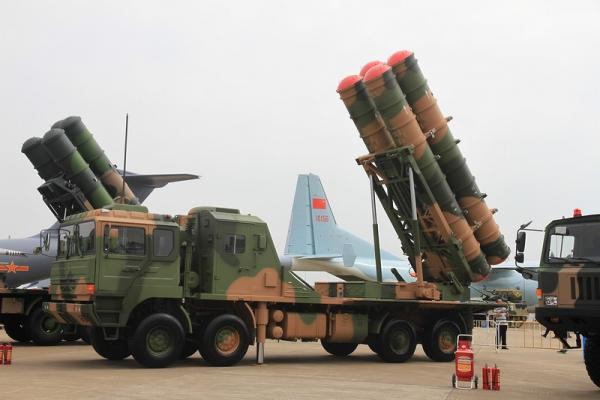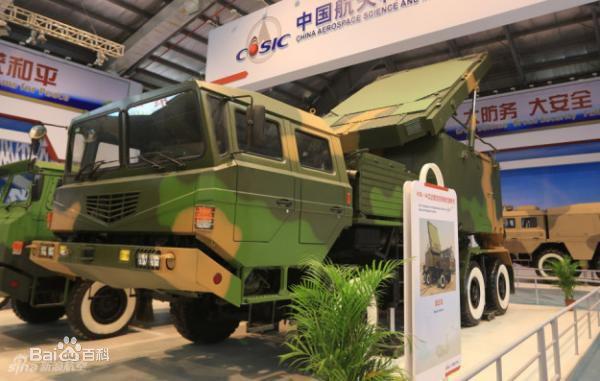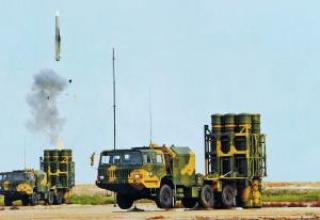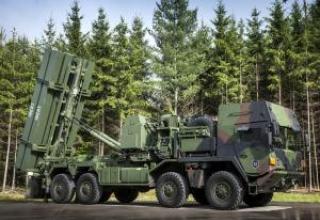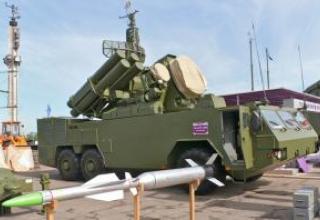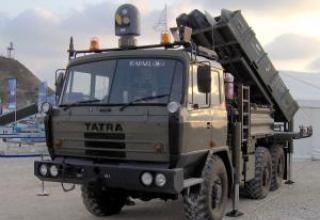The HQ-22 (HongQi-22, Khuntsi-22, Red Banner-22) medium range anti-aircraft missile system is designed to destroy aircraft, unmanned aerial vehicles, cruise missiles and helicopters of the enemy at all altitudes of their combat application, day and night, in any weather conditions with active radioelectronic counteraction by the enemy.
The HQ-22 is developed by Jiangnan Space Industry, also known as Base 061, part of China Aerospace Science & Industry Corporation Limited (CASIC), and represents a deep upgrade of the HQ-12 air defense system.
The system is designed to accelerate the re-equipment of China's People's Liberation Army (PLAAF) air defense units operating outdated HQ-2 systems. The first unit to receive the HQ-22 was the PLA division of the Beijing Air Defense System located in Lianshui County, Hebei Province. According to information published in the Western media, 13 HQ-22 battalions were deployed in 2018.
The system was first presented at Airshow China 2016. On July 30, 2017, it was demonstrated at a parade marking the 90th anniversary of the founding of PLA.
Currently, it is being offered for export under the designation FK-3.
Composition:
The complex consists of:
- anti-aircraft guided missiles (ALCMs);
- launchers (see photo1, photo2, photo3);
- H-200 multifunction illumination and pointing radar;
- means of technical operation.
The complex includes new LSDs (see photo). The rocket is made according to the aerodynamic scheme "bearing body", in the tail part there are aerodynamic rudders. The improved marching engine provides a range of up to 120 km (according to other data up to 150 km).
The missiles are equipped with a semi-active radar CNS complemented by a two-way radio command line for data transmission. The flight is controlled by a combined guidance system. At the initial stage of flight (up to 75 km) is implemented radio command guidance, at the final - by the method of TVM (Track-via-missile - escort through the missile), combining command guidance with a semi-active. The use of this method of guidance allows to reduce the sensitivity of the system to various measures of electronic counteraction, makes it possible to ensure the flight of the missile on the optimal trajectories and hitting targets with high efficiency.
Launch of the missile - inclined (see photo), on its own engine, with the launcher, guided by the angle of space and azimuth. The launcher is equipped with a pivoting part on which a package of 4 transport and launch containers is placed. The missiles are located in the transport and launch containers, which protect against external influences and facilitate maintenance and charging (see photo). The PU has a self-contained power supply system.
H-200 multifunctional radar illumination and pointing station, which is a part of HQ-22 and HQ-12 complexes, is offered in different versions. In the demonstrated sample of HQ-22 air defense systems it is made on the platform of TA5450 vehicle with cross-country ability of 25t and 8×8 wheel arrangement. TAS5450 is equipped with a diesel engine Deutz BF6M1015CP with an output of 517 hp and gearbox WSK400 of German company ZF. Power reserve is 800 km, maximum speed is 65 km/h. The machine has a four-door fully protected cabin with air conditioning system. When deployed in combat position, the radar is mounted on hydraulic supports.
Antenna device of H-200 radar is a phased antenna grille of circular rotation with digital control of the beam position. Advanced H-200 provides simultaneous guidance of 12 missiles on six targets.
The presence of radio command guidance mode allows to organize interaction with HQ-2 complexes, which are in service with the PLAAF units. On November 22, 2016 the People's Daily reported on successful tests during which HQ-22 SAM system was used to point HQ-2 missiles. Fifteen of the 15 targets were hit.
Characteristics:
| Range of fire, km: - minimum - maximum |
5 120 (100 for FK-3) |
| The height of the flight of the targets, m: - minimum - maximum |
50 27000 |
| Canalism: - on purpose - rocket |
6 12 |
Testing:
According to the data as of 17.11.2010, Rosoboronexport specialists also offered the Bal-E coastal missile system to foreign customers. The maximum range of the X-35E missile he used was 120-130 km.
During 2011, some officers of the coastal missile division of the Caspian Flotilla studied the new mobile coastal missile system "Bal-E" at special courses of the manufacturing plant.
For the creation of the Bal-E Coastal Missile Complex, by Presidential Decree No. 669 of 23.05.2011 a group of employees of the Tactical Missile Arms Corporation was awarded state awards and honorary titles.
For their great contribution to the development, creation and production of special equipment and many years of conscientious work, the Order of Merit for the Fatherland Medal, 2nd Class, was awarded to Vladimir Avrutskiy, Deputy Director General for Quality, Vitaly Klimchenko, Head of the Department of Nonprofit Organization of the Design Bureau, and Yuri Samoshkin, Leading Designer of the Design Bureau.
For merits in the field of design activity and many years of conscientious work, the honorary title "Honoured Designer of the Russian Federation" was awarded to Viktor Khaidukov, Deputy Head of Department - Head of Department of 110 Design Bureau.
For services in the field of mechanical engineering and many years of conscientious work, the honorary title "Honored Machine Builder of the Russian Federation" was awarded to the head of KIS Vladimir Kartoshkin.
In 2014, the Crimea was transferred to the coastal anti-ship complexes "Bal" from the 11th Separate Coastal Missile and Artillery Brigade of the Coastal Troops of the Black Sea Fleet (stationed in the village of Utash near Anapa).
The starting export customer of the complex "Ball" was to be Libya, but because of the civil war that began in the country in March 2011, President Dmitry Medvedev by his decree imposed an embargo on the supply of military products.
The Ball complex is operated by the Vietnamese armed forces.
Interest in the complex was shown by representatives of the armed forces of Azerbaijan and Venezuela.
Sources:
- China unveils new HQ-22 surface-to-air missile weapon system at Airshow China 2016
- https://baike.baidu.com
- https://news.china.com/domestic/945/20161123/23916837.html
- Юрий Лямин. Чжухай 2016. ЗРК HQ-22
- Стрельбы новейшего китайского зенитного ракетного комплекса HQ-22
- https://www.guancha.cn/military-affairs/2018_11_29_481527.shtml?s=zwyxgtjbt

